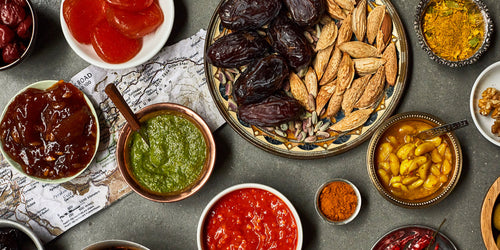Your Cart is Empty
At a time when lemon scents go into everything from kitchen cleaners to candy, it’s easy to take the humble lemon for granted. But in the days before commercial refrigeration—that is, all the days prior to 1913, when American inventor Fred Wolf brought his electric icebox to market—easy access to fresh citrus was a luxury, even in regions where they readily grew. So when a bumper crop of lemons appeared on trees, or a crate of the fragrant fruits arrived after a long ocean voyage, cooks did what they always do: they preserved them.
Lemons take well to air-drying, candying, curds, and marmalades, but one of the oldest forms of lemon preservation is also the simplest: packing them with salt. After weeks or months of curing in a brine of their own juices, the lemons’ flesh coalesces into a bracing jelly, and the rind softens into a kind of salty, spoonable candy, intensely lemony yet faintly sweet. Mild fermentation encourages a hint of musky umami to emerge, a flavor that recalls aged cheese or miso paste more than fresh fruit. In other words, salt-preserved lemons are more than something to eat when the fresh stuff isn’t around; they’re a dramatic ingredient all their own. And since they keep just about forever, there’s no reason not to keep a jar on hand.

In medieval Morocco, arguably the ancient capital of lemon growth and preservation, salt-preserved lemons were chopped fine and stirred into tagines, stews, and soups to add a bright counterpoint to heady spices and briny olives. In 18th century England, aristocratic kitchens cooked them into sauces as an exotic counterpoint to veal and salmon. You can soak or blanch the lemons to reduce their saltiness, then add them to ice cream or lemon bars for an extra twangy kick. Or purée them into a jammy paste that’s ready to mix into salad dressing or a cocktail shaker.
That lemon paste has become a pet project of Ryan Curran, whose Connecticut-based company, ACATER AND OLITER, specializes in modern interpretations of historic provisions like preserved lemons. “I was salt-curing Meyer lemons I had sourced for my own use and then puréed them just to have the purée on hand,” Curran says, “but when our clients saw I was making a purée for my own use, they asked if they could purchase it in that format.” Curran presses the paste through a fine sieve to produce a silky purée that eliminates the need to chop or mash whole lemons.
Curran started using Meyer lemons for his preserves simply because he liked the taste—they’re sweeter and less acidic than common grocery store Eureka or Lisbon lemon—but he also considers them a link to preserved lemons’ North African origins. “The traditional lemon used in Morocco for salt-curing is the Beldi variety of lemon,” he notes, “which has a gentler acidity and more rounded flavor than a standard lemon.” Meyers, he concluded, were the closest American lemon analogue, and the Meyer lemon’s natural floral aroma does indeed shine through, along with a hint of eucalyptus.
The paste is delicate enough that I feel comfortable using it with abandon—a dab in ramen broth, a smidge in my morning yogurt—without turning my meal into a bold of lemon Pledge. Yet even after building up something of a lemon habit, I’m still amazed at how a little bit goes a long way to wake up everything I cook with an electric jolt.
Chefs often say that the difference between home cooking and restaurant cooking is the amount of salt, fat, and acid used in a dish. With preserved lemons on hand, you can knock two out with one ingredient. Good thing it took the refrigerator so long to arrive.
“Good God, Lemon!”
Buy Acater & Oliter's preserved Meyer lemon paste here. Need preserved lemons instead? We have them fresh from Morocco. If you're looking for a place to start your preserved lemon adventure, try this tequila cocktail with preserved lemon, grapefruit, and lime from our friends at NY Shuk. A little dab of purée goes a long way.
Cured lemon photo courtesy of ACATER AND OLITER.





